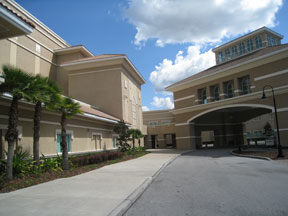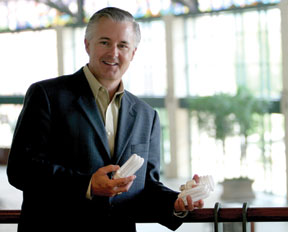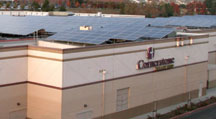
 The Catholic Community of St. Thomas More, Chapel Hill, NC
The Catholic Community of St. Thomas More, Chapel Hill, NC
When St. Thomas More expanded with new construction of a gymnasium, arts and music building, and a 29,000-square-foot parish center housing a social hall, meeting rooms and offices, the congregation’s skillful and detailed analysis, weighing overall costs versus benefits, ultimately led to the implementation of sensible and effective sustainable construction options.
The most substantial measures involved the overall approach to storm water management and water usage, specifically where savings were achieved in both systems. Installed to service the new parish center is a 15,000-gallon rain-harvesting cistern system. Harvested storm water is treated and re-used within the building for non-potable applications, namely the restroom fixtures. While the cost of the system is substantial when viewed alone, including additional piping required to deliver the non-potable water to restrooms, its implementation was extremely cost-effective.
Other water reduction measures included water-efficient fixtures in all new buildings and plant selections requiring no irrigation. The only irrigation required was for the new athletic field; however, the sustainable feature of tapping the Chapel Hill’s reclaimed water service was implemented for this irrigation, benefitting the environment while incurring less cost over the life of the field through reduced reclaim water rates.
Another notable sustainable analysis took place with respect to LED lighting. Energy calculations and potential cost savings in future years were weighed against the initial premium cost of the implementation of LED lighting. Detailed reviews by St. Thomas More reached a responsible and effective conclusion. Life-cycle savings for exterior wall pack light fixtures (at egress paths, for example) would be realized quickly enough to warrant their incorporation.
Unfortunately, costs to incorporate LED fixtures throughout interior applications simply proved to be prohibitive when evaluated in the same manner.
These initiatives exhibit St. Thomas More’s pragmatic approach and stewardship of church funds while striving to implement innovative sustainable and cost-saving features.
[Source: Emily Choate, Choate Construction Co.]
 Idlewild Baptist Church, Lutz, FL
Idlewild Baptist Church, Lutz, FL
Energy efficiency was key in the planning of the new campus of Idlewild Baptist Church that opened in 2005. In the design phase and selection of equipment of the 440,000-square-feet facility, energy-influenced decisions were made in such matters as tinted windows and a light-colored roof to reduce solar heat load. Energy Star-qualified appliances were chosen, including washers, dryers, refrigerators and dishwashers. Money was spent on the better and higher-efficiency water fixtures, chillers and lighting fixtures. A complete building automation system enables control of the HVAC, and occupancy sensors were installed in most rooms to control the electrical loads. Further investment was made to permit and drill a well to use for both landscape irrigation and a chiller water tower.
Since they were first installed, chiller flows and data from the automated system were monitored and analyzed, and systems were reprogrammed in pursuit of continuous improvement based on observed data. The church began an ongoing maintenance program with Siemens Building Technologies to maintain and optimize the automation system, which controls lighting and HVAC devices throughout the facility.
Idlewild’s technology investments include the capability for remote, wireless laptop monitoring and operator control of HVAC system adjustments in real time during high usage events such as Sunday services. This gives building managers the ability to check remotely on building status or verify reported conditions. Entering into a long-term gas purchase agreement has reduced the volatility risk and stabilized future monthly and annual natural gas costs.
Portfolio Manager, a free online tool from the Environmental Protection Agency’s Energy Star program, has become Idlewild’s formal benchmarking tool and a way to explore new opportunities for efficiency. Three Southern Baptist churches have received the Energy Star Award: Prestonwood Baptist, Plano, TX; First Baptist Church, Springdale, AR; and Idlewild.
The church reports that it is maintaining its costs, which means the energy management steps taken are effective. Management is considering for future savings replacing fluorescent lights with LED lights. The savings in utility costs is not great enough to offset the conversion costs. The conversion cost on utilities is still too high compared to the savings; yet the costs to convert are coming down.
At the same time the church is considering additional utility savings through a patented Siemens program called Demand Flow. The upfront cost/investment is holding up this decision and the need for Siemens to be more demonstrative of the actual savings/reduction in utility costs.
[Source: Ken Smith, minister of administration, and facilities manager Robert Wilson]
 Prestonwood Baptist Church, Plano, TX
Prestonwood Baptist Church, Plano, TX
Consider the possibility of saving enough dollars in energy and utility costs over the course of a year that would enable your church to start a second campus. That’s what Prestonwood Baptist Church, Plano, TX, did with an energy conservation program they initiated in 2007.
The congregation started its North Campus in Prosper, TX, with the monies it saved in energy costs. The church was able to fund all of the new campus operation with the energy savings from the Plano campus. The church has more than 15,000 people in attendance each week and 1.3 million square feet under roof and has realized cost savings of approximately $6.4 million since it began the program in 2007. Prestonwood worked with Energy Education Inc. of Dallas Cenergistic and hired an energy manager who works with training staff and communicating the conservation plan and monitoring results.
[Source: Mike Buster, executive pastor]
Solar: Responsible stewardship
 Cornerstone Fellowship, Livermore, CA
Cornerstone Fellowship, Livermore, CA
The energy conservation at Cornerstone Fellowship began with recycling, recognizing that as a small church in its early years, resource-consumption was of little consequence. But as the church’s number grew so did its sense of responsibility to lead in the Livermore community. Recycling of waste materials led to collecting and filtering run-off water and that led to the installation of solar panels on the church’s roof. The church teamed with Solar City, a leading installer of rooftop solar panels. With the panels the church began producing 43 percent of the electrical power being used on the main campus. Since installing the 1,232-panel system in 2008, the church has produced nearly $240,000 worth of electricity and offset 2,085,260 pounds of CO2. The church has been able to redirect the money it would have spent on energy and put it towards ministry in the community.
[Source: Steve Madsen, senior pastor]
——————————————————————————————————————
More Good Stewards
• Green Lakewood Church, Houston, TX
• First Methodist Church, Orlando, FL
• Piñon Hills Community Church, Farmington, NM
• Cross Church, Springdale, AR
• Saddleback Church (youth center), Lake Forest, CA
Solar
• First Presbyterian Church, Elko, NV
• Central Baptist Church, Wayne, PA


